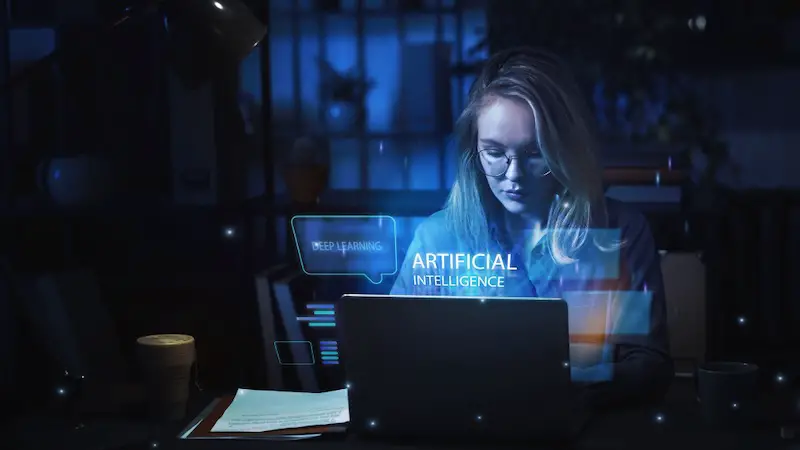The Pros and Cons of AI in Education

AI was named word of the year, with the term’s use quadrupling in 2023. The global AI market is currently valued at 207 billion dollars, with many young people worldwide already incorporating AI tools into their everyday lives.
Naturally, with AI tools becoming so easily accessible, there are bound to be advances in almost every aspect of our day to day, whether this be in the way we shop, plan our busy schedules, undertake tasks at work, or even when it comes to how we learn or undergo our education.
Commenting on the use of AI in education, a spokesperson for one of the world's largest Accredited Global training providers, The Knowledge Academy, said:
“AI has been making its way into people’s everyday lives for a while now and it seems inevitable that we’ll see it being used more often. It’s easy to see that AI can be a great asset to the education industry, allowing teachers to spend more time with students due to AI tools helping with administrative tasks and giving students the opportunity to personalize their learning practices.
But on the other hand, AI could potentially do more damage to students’ skills, like creative and critical thinking, and problem solving. Educational institutions should carefully consider all potential advantages and disadvantages of AI before making the decision to implement it.”
The potential pros and cons of implementing AI within the education sector include:
Benefits of AI in the education sector
![]()
1. Help teachers with everyday tasks
It’s been reported that one in three teachers make use of AI for school tasks. One task that takes up a considerable amount of a teacher’s time is the creation of lesson plans, which is where AI can be utilised.
AI can also easily help with key aspects of teaching, such as providing visualisations for lessons or classes, helping to plot out more creative ways of teaching certain topics, or even drawing up personalised lesson plans to meet students' specific needs.
AI tools such as ChatGPT can also assist teachers with administrative tasks, thus freeing up more of their time to focus on students.
2. Enhance the potential to suit each student’s individual needs
As AI tools can be easily accessed from almost anywhere at any time, it can be particularly advantageous for students.
Understandably, as students tend to learn at different paces, AI gives them the opportunity to access learning materials and ask questions on a subject whenever they need at a time that suits them, rather than having to reach out to their teacher each time.
For those students who learn better through visualisation, AI can again prove helpful by providing personalised content to best suit their needs.
3. Making teaching and learning more efficient
By helping teachers quickly create customised lessons to fit the needs of individual students, AI can make both the teaching and the learning process more efficient.
As well as the planning side aspects of teaching, it can also be used to help analyze students’ progress, which in turn can help to identify any potential learning gaps that need addressing by the teacher.
A UK study showed that many teachers have already been using AI tools to create interactive lessons, subject-specific assets and give personalised support to students.
Disadvantages of AI in the education sector

Whilst there are countless advantages to using AI in the teaching world, there are naturally some disadvantages that should be considered too.
1. Concerns around critical thinking
A potential issue that might arise from the use of AI in education is that it could decrease students’ critical thinking skills, a topic which is already being discussed in articles.
Students might be tempted to use AI tools for help with assignments and try to present the work as their own, which could have a negative impact on their critical thinking abilities.
Becoming too reliant on AI poses a threat not only to a student’s critical thinking skills, but also to their problem solving and creative skills as well, so it should always be used with caution.
2. Poses a threat to educators’ jobs
Whilst it can’t be known for certain, there are some concerns that implementing AI in the education industry might cause people’s jobs to become redundant longer term.
As AI provides the opportunity for automation of some administrative and teaching tasks, it could potentially jeopardize some jobs in the education sector.
Although AI can increase productivity, it should be taken into account that it can not replace the fundamental human interaction between teachers and students, which is crucial.
3. Expensive to implement
For educational institutions to provide accessibility to AI tools both to teachers and students can be quite costly. Moreover, if doing so, they would also have to allocate resources for teachers to receive appropriate training in order to be able to utilize those tools efficiently. This could potentially result in inequalities between different schools.














![7 Inspirational Quotes to Uplift You [INFOGRAPHIC] young-woman-inspired-notes-smile-inspiration-quote](/sites/default/files/styles/video_thumbnail_bottom/public/young-woman-notes-smile-inspiration-quotes.jpeg?itok=DqYtOSE1)





